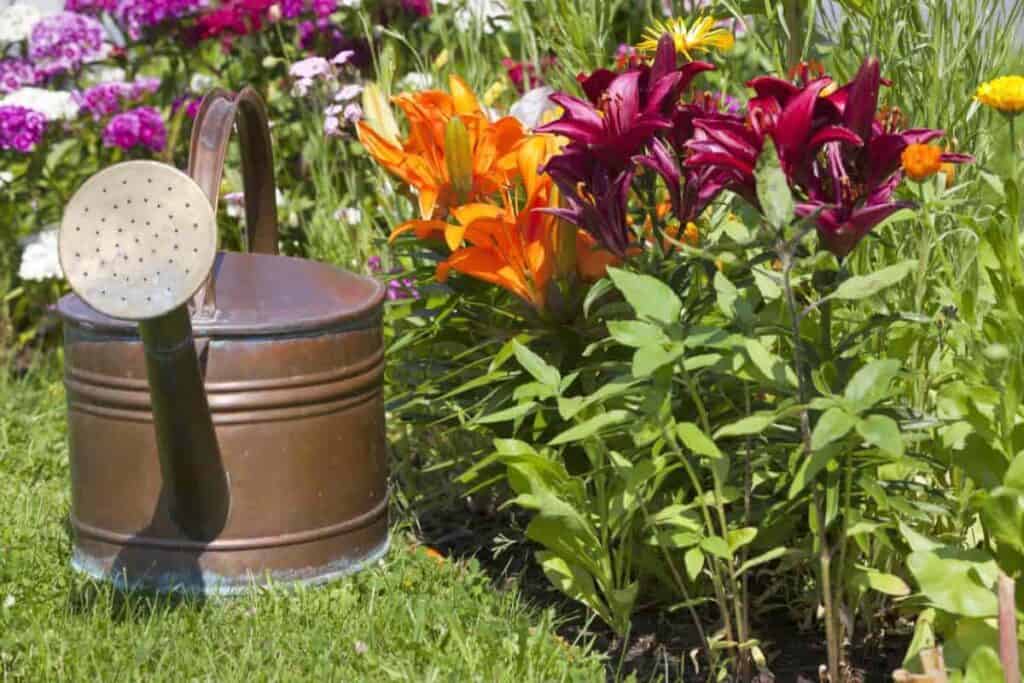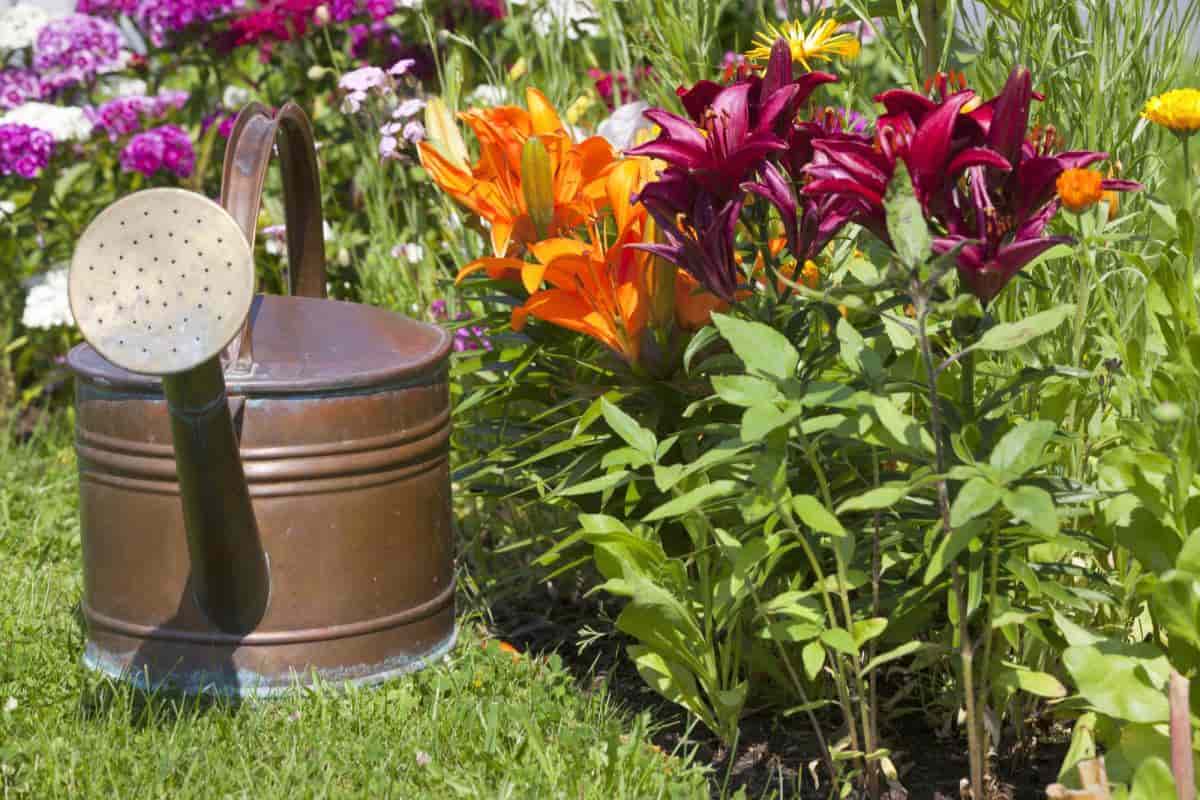When lilies became an important part of my work, and I wanted to plant the various new hybrids and the species right around my own home where I could observe their behavior closely, I found my garden was not quite suitable.
Two eminent Oregon landscape architects designed it primarily for so-called Dutch bulbs, annuals, and chrysanthemums.

By “not quite suitable,” I do not mean that it was necessary to redesign the garden but that if the emphasis were to be placed on lilies, different companion plants would have to be used.
Lilies are comparatively costly and long-lived and are best when left undisturbed. They are not limited to a short season. One species or variety succeeds another, and they extend their flowering from June to October.
This calls for good companion planting and a balance of color harmony, carefully planned, to be maintained for a long time.
Placing Lilies Carefully
Lilies, moreover, look costly. They are not pretty little ephemeral plants to be tucked in anywhere, but they are important and should be placed carefully. In planning my garden, I considered these factors.
In addition to wanting to put lilies in as suitable a setting as possible, I wished to see how they would behave under average conditions; to simulate, in at least one part of the garden, the conditions encountered by the average home gardener who buys a few bulbs each year.
I also wanted to plant a section of the garden with lilies for display and photographic purposes; to grow clumps of beautiful specimens regardless of cost; to set out, at the right time, large, select, single crown bulbs of new varieties that would make a perfect picture the next year.
Lily Museum
My third desire was to provide a haven for the rare species and hybrids that, for one reason or another, did not lend themselves to large-scale, commercial production. This last planting, my lily museum, has given me the most trouble.
The “rare” lilies, or at least most of them, have fixed preferences for certain soils and climates. Often they did not thrive and usually multiplied slowly in my garden.
My little museum, nevertheless, has taught me a lot about lilies. It also has substantiated many of the findings of my expert lily growers.
They could not do much with certain lilies, nor could I with even more care and under better conditions. In all my years with them, only one has been promoted from the museum to the fields.
This is the charming little L. lankongense. And, to be truthful, it was not until I received fresh stock from Dr. Joseph Rock (who discovered a stronger variant) that I could grow it in quantity in the fields.
Gardening With Lilies
Gardening with countless lilies right around my residence has given me an unusual opportunity to work out suitable color schemes with them and their companion plants.
It also has made me realize that it is not so much the color of lily blooms that strikes discordant notes as their shape and size.
Insofar as background and companion plants are concerned, too, I have had to avoid rivalry not of color so much as precedence.
There is nothing against having a spectacular tree peony next to lilies, for instance, so long as it flowers at a different time.
June-Flowering Species
The matter of different lilies clashing was of special interest to me. I have in mind a border with June-flowering species such as:
- L. amabile
- Yellow counterpart L. amabile luteum;
- L. pumilum
- Orange sport L. pumilum Golden Gleam;
- L. concolor
- Lovely yellow form known as Coridion;
- L. cernuum, the purple L. martagon
- And the even better pure white L. martagon album
The varicolored, variformed lilies in this group flower at about the same time most harmoniously.
A few bulbs of L. rubellum and L. japonicum planted on the same border, however, were off-key. Rather than their colors, their trumpet flowers did not belong and clamored for a different setting.
The lilies named first are planted in little groups with a new strain of aquilegia and other perennials in a corner against a broad semicircle of species rhododendrons. By the way, such a planting obviously needs a large garden as it consists of a great deal of material.
Out of place on the same border, the little trumpet lilies are now in a rock garden. I created a quiet and perfect haven for them by rearranging some large rocks to form a triangle.
The soft pink of the lilies flowering between Anthemis Aizoon against the lovely gray of the rocks and the deep green of a prostrate juniper is charming.
I am now experimenting with some of the new Gypsophila repens Rosy Veil in the same setting.
Native Lilies
A garden like mine is in a constant state of change and upheaval. This is particularly true of a section devoted to native lilies.
Here, my problem was not so much finding good companion plants as it was keeping the more boisterous species within bounds and maintaining breathing room for weaker ones.
The Mount Hood Lily (L. Washingtonianum) and similar species do well only if they have no competition from stronger lilies. L. pardalinum, for instance, is always ready to take over.
The huge clumps it makes in 3 or 4 years soon overshadow such smaller lilies as L. columbianum and L. parryi, which I am so fond of. In my garden, L. humboldti has been very good, incidentally, as have L. kelloggi and L. canadense.
I must confess, however, that as well-behaved in the garden, interesting and beautiful as these lilies are, they are eclipsed by the new hybrids.
The Bellingham Group
A living monument to the memory of Dr. David Griffiths, is unsurpassed and, among its widely varying representatives, contains most types of the best native lilies.
Add to the Bellinghams a planting of the Sunset Lily which to all purposes is nothing but a large and strong-growing L. pardalinum, and you have as fine a range of colors and types as can be attained.
These lovely plants I grow among hardy ferns and funkias against a background of lilacs and other flowering shrubs.
Combination of Plants
For various reasons, I shall refrain from describing other combinations which have proven their merit in my garden.
One good reason is that my garden is on the western slopes of Mount Hood and that my climate differs from that of most readers.
Companion plants that I can grow may not be hardy elsewhere. Others that I can keep within bounds and in proper balance with the lilies might run away and crowd out the same lilies in another garden.
Furthermore, I firmly believe that all gardeners should test plants and combinations of plants on their grounds rather than merely follow advice. They should study catalogs of leading nurseries and select from them the best material offered each year.
For, in the end, it is the home gardener and not the horticultural expert who knows what suits him best and what grows best in his place.
If I must reveal some of my happier combinations, I might say that the new Anthemis Grallagh Gold, with its golden flowers so ideal for cutting, makes a perfect foil for the blazing colors of the Mid-Century Hybrid lilies and that Aconitum wilsonii, the true late-flowering blue Monkshood, combines with the apricot Aurelian lilies to make an unforgettable picture.
Ajuga genevensis does the same for the lacquer-red L. concolor.
The tall hybrids of Armeria as well as the azure-blue flowers of Linum Narbonense look lovely with the Fiesta Hybrid lilies.
With its silvery foliage, the Russian Sage (Perovskia atriplicifolia) makes a good companion for many lilies and enjoys the sunshine as much as they do.
I pick these examples at random. Many others are already tested and found to be good, and others are still to be tried next year.
Finding a place for the tall, majestic new Aurelian and Olympic Hybrid lilies is more difficult but also more fun. Their sensuous, plastic beauty needs an unobtrusive, dignified background.
My solution, admittedly an expensive one, is to combine them with a select group of the finest new rhododendron and azalea hybrids.
Bushy Rhododendrons
The beauty of bushy rhododendron hybrids May Day and Vanguard laden with lovely red clusters is intensified by the rapidly growing, attractive foliage of the strong trumpet lilies then just 2 feet tall.
As the rhododendrons finish blooming, the lilies get taller, buds unfold and open, and the lilies dominate the space they and the rhododendrons occupy, while the latter simply provide a contrast in foliage.
This is a two-season planting only insofar as flowers are concerned. It is an all-season one when the foliage’s interesting development is considered.
Trumpet Lilies
What I planted as single bulbs of selected Olympic and Aurelian trumpet lilies have, in a few years, split up to form groups of three or more stalks. Each plant in a group is part of a single bulb (a clone) and is identical to others within the group in all characteristics.
But each group differs from every other, and it is just this that gives character to this part of the garden.
44659 by Jan De Graaff
